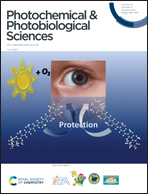Matrix-dependent absorption of 8-methoxypsoralen in extracorporeal photopheresis
Abstract
Background: Extracorporeal photopheresis (ECP) is an effective immunomodulatory therapy for various diseases. Autologous leukocytes are collected, photoactivated with a photosensitizer (8-methoxypsoralen, 8-MOP) and UVA light, and subsequently reinfused back to the patient. Leukapheresis and UVA irradiation systems can be integrated into one device (inline) or handled by two separate devices (offline). ECP works via intercalation of 8-MOP into DNA helices and UVA-based interactions to inhibit DNA replication. 8-MOP is known to adhere to plastic materials, which might reduce its availability for intercalation. In the present study we examined the bioavailability of 8-MOP when different plastic materials and solvents are used as matrices. Methods: Varying amounts of shredded ethylene vinyl acetate (EVA) and polyvinylchloride (PVC) from the MacoGenic irradiation bag (EVA1), UVA PIT irradiation bag (EVA2), UVA PIT recirculation bag (PVC A) and UVA PIT tubing (PVC B) by MacoPharma and PIT Medical Systems, respectively, were incubated with 200 ng mL−1 8-MOP dissolved in diisopropyl ether (DIPE) plus toluene 90/10 vol%, deionized water or plasma. After 2 h 8-MOP concentrations were determined by GC-MS. Results: After incubation, 8-MOP concentrations varied depending on the amount and type of plastic (PVC > EVA) and solvent (water > plasma > DIPE/toluene). Absorption to 200 mg EVA1 or EVA2 resulted in 8-MOP concentrations of 57% or 32% in water, 91% or 80% in plasma, and 93% or 92% in DIPE/toluene, while 200 mg PVC A and PVC B yielded recovery rates of 26% and 10% in water, 76% and 75% in plasma, and 55% and 30% in DIPE/toluene, respectively. Remaining 8-MOP differed significantly between container materials (EVA vs. PVC; p < 0.022) but not manufacturers (MacoPharma vs. PIT Medical Systems). Conclusion: Absorption loss of 8-MOP depends on the type of plastic and solvent and is more pronounced with water than with plasma. As the DNA binding effect of 8-MOP is dose-dependent, ECP starting doses should be adjusted to ensure that a sufficient concentration of free bioavailable 8-MOP is present during UV irradiation.



 Please wait while we load your content...
Please wait while we load your content...